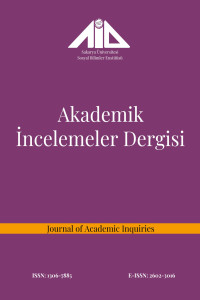Abstract
Heidegger's philosophical project is generally seen as atheoretical and anti-logical because he remarked on the subjective conditions of knowledge and the everydayness of human behaviors. To him, Dasein's everyday reasoning is coercively and inevitably framed by the present-at-hand modes of understanding. Heidegger alerts us about the possible origins of present-at-hand modes of everyday experience. One of them is Das Man that, is associated with a categorical otherness for Heidegger. It can be regarded as an origin of the primordial scheme of experiences for Dasein that takes those experiences for granted as an axiological ground for their lives in the World. Heidegger sees that process as an inauthentic condition for Dasein's fundamental character. Everyday reasoning generates a variety of present-at-hand instruments to understand and interpret the World and Dasein itself; thus, Dasein moves between Das Man and authentic modes. With a Heideggerian approach, this article observes how the characters in the film Druk take themselves out of Das Man and go into the authentic mode and how they do this through alcohol. The primary data source is Druk and the four teacher characters in the film. In the movie, alcohol is not a ready-to-hand object but a tool motivating its users and pushing them to perform. It is an example equivalent to the Heideggerian analogy of the hammer. The movie is a well-fitting example of the Heideggerian position with the story of four teachers who experiment with having a certain amount of alcohol in their blood to achieve a better version of themselves.
Keywords
References
- Audi, Robert (ed.). The Cambridge Dictionary of Philosophy, N.p.: Cambridge University Press, 3rd ed., 2015.
- Dahlstrom, Daniel O. “Heidegger's Method: Philosophical Concepts as Formal Indications”. The Review of Metaphysics 47/4 (1994, June), 775-795.
- Dastur, Françoise. “Logic and Ontology: Heidegger's ‘Destruction’ of Logic”. Research in Phenomenology 17 (1987), 55-74.
- Dreyfus, Hubert L. “Why Heideggerian AI Failed and How Fixing It Would Require Making It More Heideggerian”. Philosophical Psychology 20/2 (2007), 247-268. https://doi.org/10.1080/09515080701239510
- Heidegger, Martin. Being and Time. çev. John Macquarrie - Edward Robinson. Cornwall: Blackwell, 2001.
- Heidegger, Martin. Varlık ve Zaman. çev. Kaan H. Ökten – Alfa Yayınları, 2018.
- Inwood, Michael. A Heidegger Dictionary. Maiden, MA: Blackwell Publishers, 1999.
- Inwood, Michael. Heidegger: A Very Short Introduction. Oxford University Press, 2019.
- Jacquette, Dale (ed.). A Companion to Philosophical Logic. Oxford: Blackwell Publishing, 2006.
- Kant, Immanuel. Critique of Pure Reason. çev. Paul Guyer - Allen Wood. Cambridge: Cambridge University Press, 1999.
- Käufer, Stephan. “Schemata, Hammers, and Time: Heidegger’s Two Derivations of Judgment”. Topoi 22 (2003), 71-93.
- Marcuse, Herbert. Negations: Essays in Critical Theory. çev. Jeremy J. Shapiro. London: MayFlyBooks, 2003.
- Seguna, Josephine A. “Disability: An Embodied Reality (or Space) of ‘Dasein’”. Human Studies 37/1 (2014), 31-56.
- Wheeler, Michael, “Martin Heidegger”, The Stanford Encyclopedia of Philosophy (Fall 2020 Edition), Edward N. Zalta (ed.). Erişim 10 Ocak 2023. https://plato.stanford.edu/archives/fall2020/entries/heidegger/
Abstract
Heidegger’in felsefi projesi genellikle, insan davranışlarının gündelik karakteri ve bilginin öznel koşullarına dair açıklamalarından ötürü, ateorik ve anti-mantıksal olarak görülür. Ona göre, Dasein’in günlük akıl yürütmesi, elde-mevcut anlayış biçimleri üzerinden kaçınılmaz bir biçimde çerçevelenir. Heidegger gündelik deneyimin el-altında-bulunma biçimlerinin olası kökenleri konusunda bizi uyarır. Bunlardan biri Das Man'dır (Onlar). Das Man, Heidegger için kategorik bir ötekilikle ilişkilidir. Dasein için deneyimlerin ilksel şemasının bir kökeni olarak görülebilir. Dasein bu deneyimleri Dünya'daki yaşamları için aksiyolojik bir zemin olarak kabul eder. Heidegger bu süreci Dasein'ın temel karakteri için otantik olmayan bir koşul olarak görür. Gündelik akıl yürütme, Dünya'yı ve Dasein'ın kendisini anlamak ve yorumlamak için el altında bulunan çeşitli araçlar üretir; böylece Dasein, Das Man ve otantik modlar arasında hareket eder. Bu makale Heideggerci bir yaklaşımla Druk (2020) filmindeki karakterlerin kendilerini Das Man içerisinden çıkararak otantik moda geçmelerini ve bunu alkol üzerinden gerçekleştirmelerini gözlemlemiştir. Betimsel analiz yönteminin kullanıldığı bu çalışmada temel veri kaynağı olarak Thomas Vinterberg’in yönetmenliğini yaptığı Druk filmi ve filmin içerisinde yer alan dört öğretmen karakter ele alınmıştır. Filmde alkol el-altında-olan obje olarak değil kullanıcılarını motive eden ve onları performans göstermeye iten bir araç olarak yer alır ve Heideggerci “çekiç” benzetmesine eşdeğer bir örnektir. Film, kendilerinin daha iyi bir versiyonunu elde etmek için kanlarında belirli bir miktarda alkol bulundurmayı deneyen dört öğretmenin hikâyesi ile Heideggerci pozisyonun çok iyi uyum sağlayan bir örneğidir.
Keywords
References
- Audi, Robert (ed.). The Cambridge Dictionary of Philosophy, N.p.: Cambridge University Press, 3rd ed., 2015.
- Dahlstrom, Daniel O. “Heidegger's Method: Philosophical Concepts as Formal Indications”. The Review of Metaphysics 47/4 (1994, June), 775-795.
- Dastur, Françoise. “Logic and Ontology: Heidegger's ‘Destruction’ of Logic”. Research in Phenomenology 17 (1987), 55-74.
- Dreyfus, Hubert L. “Why Heideggerian AI Failed and How Fixing It Would Require Making It More Heideggerian”. Philosophical Psychology 20/2 (2007), 247-268. https://doi.org/10.1080/09515080701239510
- Heidegger, Martin. Being and Time. çev. John Macquarrie - Edward Robinson. Cornwall: Blackwell, 2001.
- Heidegger, Martin. Varlık ve Zaman. çev. Kaan H. Ökten – Alfa Yayınları, 2018.
- Inwood, Michael. A Heidegger Dictionary. Maiden, MA: Blackwell Publishers, 1999.
- Inwood, Michael. Heidegger: A Very Short Introduction. Oxford University Press, 2019.
- Jacquette, Dale (ed.). A Companion to Philosophical Logic. Oxford: Blackwell Publishing, 2006.
- Kant, Immanuel. Critique of Pure Reason. çev. Paul Guyer - Allen Wood. Cambridge: Cambridge University Press, 1999.
- Käufer, Stephan. “Schemata, Hammers, and Time: Heidegger’s Two Derivations of Judgment”. Topoi 22 (2003), 71-93.
- Marcuse, Herbert. Negations: Essays in Critical Theory. çev. Jeremy J. Shapiro. London: MayFlyBooks, 2003.
- Seguna, Josephine A. “Disability: An Embodied Reality (or Space) of ‘Dasein’”. Human Studies 37/1 (2014), 31-56.
- Wheeler, Michael, “Martin Heidegger”, The Stanford Encyclopedia of Philosophy (Fall 2020 Edition), Edward N. Zalta (ed.). Erişim 10 Ocak 2023. https://plato.stanford.edu/archives/fall2020/entries/heidegger/
Details
| Primary Language | English |
|---|---|
| Journal Section | Reserch Articles |
| Authors | |
| Publication Date | April 15, 2023 |
| Submission Date | February 1, 2023 |
| Published in Issue | Year 2023 Volume: 18 Issue: 1 |



